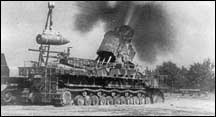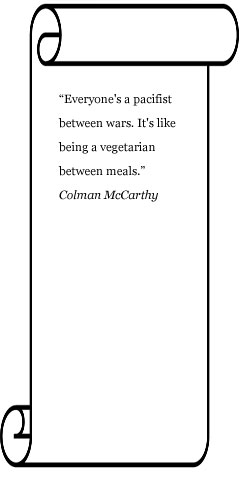| The
'Karl' Self-Propelled Siege Mortar
By Mike Bennighof, Ph.D.
September 2012
During the First World War, the Austro-Hungarian
army’s heavy siege mortars helped the
Germans destroy Belgian fortresses and advance
on Paris. Once the Nazi regime began re-arming
and considering future warfare, the need for
heavy artillery to smash the new fortifications
of the Maginot Line and similar works became
apparent.
In 1937, the Army ordered a 600mm self-propelled
siege mortar from Rheinmetall-Borsig, the
conglomerate which built most of the German
Army’s artillery. Named “Karl”
for Karl Becker, the artillery general charged
with program oversight, a prototype was produced
in 1939 and driving trials took place in May
1940.
| 
The “Karl” prototype vehicle.
|
The first production models, named Adam and
Eve, were delivered in the first week of November
1940, well after the campaign in France and
Belgium had ended. A third weapon, named “Thor,”
arrived in February 1941 and a fourth, “Odin,”
in April. The four vehicles were assigned
to the 628th Heavy Artillery Battalion and
grouped in two two-gun batteries for the invasion
of the Soviet Union. A fifth vehicle, “Loki,”
was delivered in June and a sixth, “Ziu,”
in August; these operated at the siege of
Sevastopol as the 833rd Heavy Artillery Battalion.
A very large vehicle, the Karl self-propelled
mortar weighed 124 tons and was 11.37 meters
long; a Royal Tiger tank, in contrast, weighed
68 tons and was 10.3 meters long. The Daimler-Benz
MB507 diesel engine could move the huge gun
at a speed of 10 kilometers per hour, though
its ground pressure was enormous and it could
not cross many bridges. It appears to have
badly damaged most roadbeds it crossed. Before
firing, the vehicle would lower itself to
ground level to take recoil pressure off the
tracks.
| 
The mortar “Thor” on its
special railway carriage.
|
Though officially “self propelled,”
the guns did most of their travelling by rail.
A special set of rail cars held the big mortar
suspended between them. For longer road distances,
the mortar would be disassembled and then
put back together at its firing site using
a special 35-ton crane. Once assembled, the
mortar could fire one round about every 10
minutes. The two-ton shells had a very high
trajectory, but a range of only 6,800 meters.
The first four mortars shelled Lvov in July
1941. The relatively short range had already
concerned the designers before their first
action, and in May 1942 longer 540mm barrels
were ordered for all six vehicles. These would
be interchangeable with the shorter, larger
weapon, allowing the guns to swap range for
firepower. The 540mm version had a range of
about 10,400 meters, and launched a shell
weighing about one and a half tons. When carrying
the 600mm barrel the vehicle was known as
Gerät 040, and when mounting the 540mm
they were designated Gerät 041.
The guns saw relatively little action; the
war would not be one with many protracted
sieges. They performed well at Sevastopol
in the summer of 1942, and would be transported
northward for the abortive assault on Leningrad
later that year. They probably saw their most
sustained use during the “Warsaw Rising”
of August 1944, pouring heavy shells into
civilian neighborhoods in a vain effort to
break the Polish Home Army’s will through
terror and murder.
| 
Weapon of mass terror. “Ziu”
fires on Warsaw, 21 August 1944.
|
The Red Army took one vehicle (“Adam”)
back to the Kubinka armor museum as a trophy
of war, while the Americans hauled off Eve
and Loki. The big mortars arrived on the scene
too late for the campaign for which they had
been designed, but their huge size made them
favorites of Nazi propaganda photographers.
They proved difficult to use in practice thanks
to their very short range; they could only
be deployed behind a very stable front and
became a tempting target for counter-battery
fire and raiding parties.
We provided two of them in our Panzer
Grenadier: Edelweiss supplement, one
of each version on special double-sized game
pieces. We did not, however, include rules
for their use. Here are a few.
Special Rules for 'Karl'
1. The Karl mortar must wait one turn between
moving and beginning its firing sequence (the
crew is preparing the weapon). It may not
come under enemy fire of any type or undertake
any game action.
2. The Karl mortar’s fire must be pre-plotted
in the preceding turn: the German player writes
down the target hex (do not reveal this to
the opposing player). During a plotting turn,
the Karl mortar may neither move nor fire,
nor come under enemy fire of any type or undertake
any game action. If any of these occur, the
Karl mortar may not fire in the next turn.
As with all bombardment fire, the target hex
must be spotted during the plotting turn.
3. Once fire has been plotted, the Karl mortar
may fire on the same target hex each turn.
For example, the Karl mortar may move on Turn
Three and Four, prepare to fire on Turn Five,
plot its fire on Turn Six and fire on Turn
Seven. It may fire once each turn thereafter
as long as it fires on the same target hex.
If the German player wishes to shift to another
target hex, the Karl mortar must spend one
turn plotting the new target.
4. The Karl mortar may fire only on its pre-plotted
target hex, and must carry out its fire mission
(if a German unit moves into the hex in the
interim, it’s a very big mistake for
the Germans). The German player receives no
friendly fire (9.52) modifier for the Karl
mortar’s fire; it strikes German units
in an adjacent hex on a result of 1 or 2.
Click
here to buy Edelweiss, and your very
own Karl mortar counters! |


